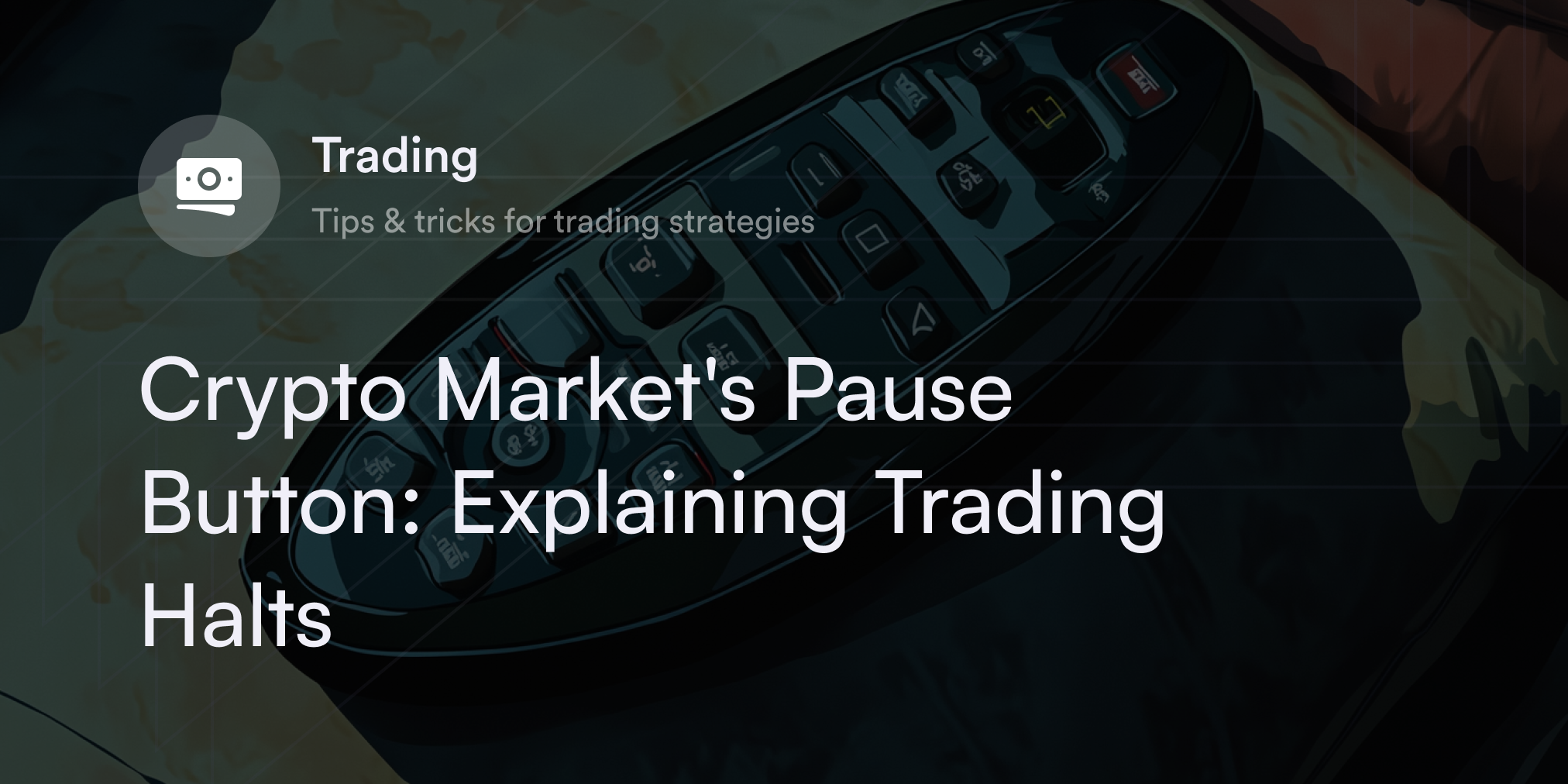


Although everyone's watching the same crypto price feeds, traders don't always agree on how to interpret the data on their screens. To one trader, it may look like Bitcoin (BTC) is about to burst upward; for another, BTC looks set for a breakdown.
While there's no way to know the future trajectory for a cryptocurrency's price, traders have tools — technical indicators — to predict the most likely scenarios. For instance, pivot points are a widely used tool in the crypto market to analyze daily price fluctuations. Many crypto traders won't make a major decision without at least consulting where these points are on their target price chart.
Not every crypto trader is a pivot point partisan, but they’re a common way to get a bird's eye view of short-term price action. In this guide, we’ll tell you how pivot point trading works, why it's so popular, and how to use it when setting up crypto positions.
What is a pivot point in crypto trading?
Pivot points are technical indicators that use prior price levels to calculate horizontal averages on a cryptocurrency's current price chart. Often, traders use the sum of the high, low, and closing prices from the previous day's trading session and divide by three to figure out the pivot point for the next day. With this pivot point value, traders use other formulas to determine a cryptocurrency's critical support and resistance zones.
Although pivot points are commonly used as an intraday trading tool, they aren't exclusively for 24-hour intervals. Sometimes, traders use pivot points on weekly timeframes to spot multi-day trends, while others use data from the previous few hours or minutes to analyze microtrends. Whatever time interval crypto traders use, pivot points provide a frame of reference when analyzing market sentiment and constructing trade set-ups.
How to calculate a classic pivot point trade strategy
To figure out the pivot point for a cryptocurrency, first choose a timeframe to examine (e.g., weekly, daily, or hourly). Next, write down the highest, lowest, and closing prices during the most recent period you're studying. Lastly, add these three numbers and divide them by three to determine the pivot point for an upcoming trading session.
For example, suppose a trader wants to find the intraday pivot point for Bitcoin. They'd first look for BTC's high, low, and closing prices in the previous 24-hour session. If these prices were $26,500, $24,000, and $24,500, they put these values into the following formula:
($26,500 + $24,000 + $24,500) / 3 = $25,000
With this info, traders put a horizontal line at $25,000 for the next day's trading session. They also use this pivot point to visualize strong support and resistance areas on a daily trading chart. Support lines show price zones where cryptocurrencies tend to bounce on the downside, while resistance levels are higher prices that cryptocurrencies struggle to push through unless they're in a strong upward (or bullish) trend.
The formulas for the six major support and resistance levels in pivot point trading are:
Resistance 1 (R1): 2*Pivot Point - Previous Price Low
Support 1 (S1): 2*Pivot Point - Previous Price High
Resistance 2 (R2): Pivot Point + (Price High - Price Low)
Support 2 (S2): Pivot Point - (Price High - Price Low)
Resistance 3 (R3) = Previous High + 2(Pivot Point - Previous Low)
Support 3 (S3) = Previous Low - 2(Price High - Pivot Point)
For the above Bitcoin example, the calculations work as follows:
R1: 2*$25,000 - $24,000 = $26,000
S1: 2*$25,000 - $26,500 = $23,500
R1: $25,000 + ($26,500 - $24,000) = $27,500
S2: $25,000 - ($26,500 - $24,000) = $22,500
R3: $26,500 + 2($25,000 - $24,000) = $28,500
S3: $24,000 - 2($26,500 - $25,000) = $21,000
If a crypto exchange offers technical analysis features, they likely have standard pivot point visualization tools, so traders don't have to break out a calculator to determine these values. Remember, pivot points are often set to "daily" as a default, so be sure to double-check the pre-selected time horizon and adjust the settings when plotting these values.
How do crypto traders use a pivot point strategy?
Day traders use pivot points to reveal transparent info on critical levels and the most recent trend for a cryptocurrency's price. Suppose a token trades below a pivot point at the start of a session. In that case, it has a downward (or bearish) bias, meaning traders expect it's more likely for the price to continue going down without a strong reversal.
Conversely, when a token is above a pivot point, it's in an upward bullish pattern, and traders expect this momentum to continue unless it breaks below the middle line in a trading session. Traders consider these biases early in a trading session and use the support and resistance values to set their buy or sell orders and manage their maximum risk versus expected return.
Traders also use pivot points alongside other technical indicators to inform their trading thesis and pick the optimal levels to buy or sell a digital asset. For instance, it's common to overlay pivot points with moving averages (MAs), which are lines symbolizing the median price of an asset over a predefined period of days. If a pivot point converges with one or more MAs, chances are it's a significant zone of support or resistance. Other popular indicators traders use with pivot points include Bollinger bands, Fibonacci retracements, and the Ichimoku Cloud.
Benefits and risks of using a pivot point indicator
Pivot points provide valuable info on an asset's recent trends and key price zones, but they’re not a foolproof tool. Before using pivot point values to set up a crypto trade, consider the pros and cons.
Pivot point pros
Easy to solve and visualize: Even if traders have math anxiety, it's not difficult or time-consuming to figure out pivot point values over a set period. As long as traders know the high, low, and close in the most recent daily, weekly, or hourly trading session, they have everything they need to find the pivot point and associated support and resistance lines. Plus, it's common for crypto trading platforms with technical analysis tools to have pre-built pivot point visualizations.
Helps traders choose calculated buy and sell levels: The transparency of pivot points makes it easy for traders to spot favorable levels for their short-term buy and sell orders. Even if a trade doesn't go as expected, traders define their max loss potential with stop-losses near or at critical pivot points.
Reveals info on market bias: Even novice technical analysts have a simple time determining whether a cryptocurrency is bullish or bearish with pivot points. Prices above pivot points are bullish, but those below are bearish. Although these initial biases don't always play out, they give traders a clue about recent price trend developments.
Pivot point cons
Only suitable for short-duration trades: Crypto traders interested in long-term strategies like HODL and dollar-cost averaging (DCA) get more value from fundamental analysis versus technical tools like pivot points. Since pivot points typically use less than a week's worth of info, they're designed for day and swing traders.
Commonly used strategy: Calculating pivot points isn't a secret science in crypto trading circles, and sophisticated high-frequency trading programs often use this data in their algorithms. Because many professional traders use pivot points to develop fast, automated strategies, they raise the odds of crowded trades and increased competition.
Doesn't respond to real-time market dynamics: Pivot points only give traders a static price estimate with the prior day or week's trading data, so they won't continuously adjust during a volatile trading session. While the inflexibility of pivot points helps traders pick calculated levels, they can't provide real-time hints on a cryptocurrency's trend.
Eligible traders can set up pivot points with crypto perps on dYdX
Whether traders prefer pivot points, Bollinger bands, or another technical indicator, dYdX has ways for eligible traders to set up precise buy and sell orders on dozens of crypto perpetuals. On dYdX's decentralized exchange, eligible traders also have the power to select their preferred slippage tolerance and order types before placing their positions. Check out our official blog for more details on how dYdX works and our latest feature upgrades, and visit dYdX Academy for more information on trading techniques, crypto technology, and Web3.
Eligible traders can start trading on dYdX today!
Terms & Conditions and Disclosures
The content of this article (the “Article”) is provided for general informational purposes only. Reference to any specific strategy, technique, product, service, or entity does not constitute an endorsement or recommendation by dYdX Trading Inc., or any affiliate, agent, or representative thereof (“dYdX”). Use of strategies, techniques, products or services referenced in this Article may involve material risks, including the risk of financial losses arising from the volatility, operational loss, or nonconsensual liquidation of digital assets. The content of this Article does not constitute, and should not be considered, construed, or relied upon as, financial advice, legal advice, tax advice, investment advice, or advice of any other nature; and the content of this Article is not an offer, solicitation or call to action to make any investment, or purchase any crypto asset, of any kind. dYdX makes no representation, assurance or guarantee as to the accuracy, completeness, timeliness, suitability, or validity of any information in this Article or any third-party website that may be linked to it. You are solely responsible for conducting independent research, performing due diligence, and/or seeking advice from a professional advisor prior to taking any financial, tax, legal, or investment action.
You may only use the dYdX Services in compliance with the dYdX Terms of Use available here, including the geographic restrictions therein.
Any applicable sponsorship in connection with this Article will be disclosed, and any reference to a sponsor in this Article is for disclosure purposes, or informational in nature, and in any event is not a call to action to make an investment, acquire a service or product, or purchase crypto assets. This Article does not offer the purchase or sale of any financial instruments or related services.
By accessing this Article and taking any action in connection with the information contained in this Article, you agree that dYdX is not responsible, directly or indirectly, for any errors, omissions, or delays related to this Article, or any damage, injury, or loss incurred in connection with use of or reliance on the content of this Article, including any specific strategy, technique, product, service, or entity that may be referenced in the Article.







